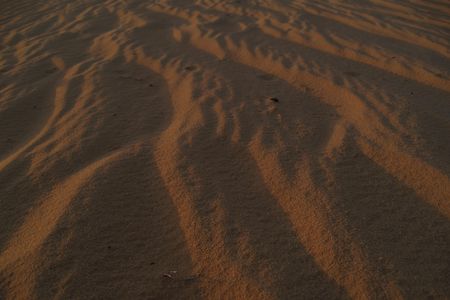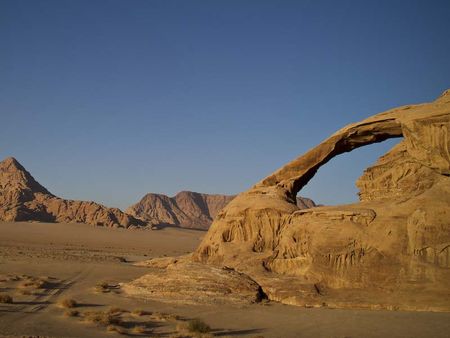In the desert
Back from Kenya, I had no time to rest. Voyage TV gave me another assignment. "Where would I go next?" "Jordan". I started to feel dazed by the countries I was sent to.
"Jordan" did not mean much to me. I knew very little about the Kingdom, and I had just a few days to research about its history, its culture and its landscapes. But after a while, I understood that my assignment would be a fantastic journey. Along the King's Highway, I will eventually get lost into the Wadi Rum desert and the ancient city of Petra.
The mountains in Wadi Rum are made of sand stones. Erosion for thousands of years led to spectacular rock formations.
Mohammed,
our guide, told about the story of the beduins, their generosity, and
the absolute necessity of sharing in such hostile environment. Not long
after, we heard a Jeep roaring in the distance. They were about to pass
us when they saw us. Quickly, the driver did a bend and came in our
direction. "How everything is going? Are you ok? Do you have
cigarettes?" I gave them my pack and was a bit surprised when they took half of it. But weren't we beduins for a day?
told about the story of the beduins, their generosity, and
the absolute necessity of sharing in such hostile environment. Not long
after, we heard a Jeep roaring in the distance. They were about to pass
us when they saw us. Quickly, the driver did a bend and came in our
direction. "How everything is going? Are you ok? Do you have
cigarettes?" I gave them my pack and was a bit surprised when they took half of it. But weren't we beduins for a day?
Desert can be surprising. I had just
learned it. Generosity is a key word, as much as survival. And you can
be moved by a single little plant. Or by stunning sunsets.
The next day, early morning. We hit the road again to get to Petra, the forgotten city. On
our way, we met a shepard. Ali and his family were living in the
mountainous region of Petra. Sheeps were like cottons flowers in the
distance.
What could be said about Petra,
home of the long gone Nabataean civilization? The Nabataeans were an
ancient Semitic people who loosely-controlled trading network between
Syria and the Red Sea. If the origins of the Nabataeans remain obscure,
their heritage is still there and is a testimony of their great
architectural skills. Trajan definitively conquered the Nabataean
kingdom, annexing it into the Roman Empire,
where their individual culture, easily identified by their
characteristic finely-potted painted ceramics, became dispersed and was
eventually lost.
Nabataeans lived in troglodyte houses like these ones. 
And like Nabataeans of yesterday...
Jordanians of today still use camels


/https%3A%2F%2Fstorage.canalblog.com%2F44%2F14%2F398550%2F33692032_o.jpg)
/https%3A%2F%2Fstorage.canalblog.com%2F31%2F97%2F398550%2F33689481_o.jpg)
/https%3A%2F%2Fstorage.canalblog.com%2F92%2F57%2F398550%2F33686978_o.jpg)
/https%3A%2F%2Fstorage.canalblog.com%2F39%2F34%2F398550%2F33683714_o.jpg)
/https%3A%2F%2Fstorage.canalblog.com%2F76%2F40%2F398550%2F33681547_o.jpg)
















/https%3A%2F%2Fstorage.canalblog.com%2F72%2F40%2F398550%2F33690999_o.jpg)
/https%3A%2F%2Fstorage.canalblog.com%2F60%2F36%2F398550%2F33690116_o.jpg)
/https%3A%2F%2Fstorage.canalblog.com%2F63%2F64%2F398550%2F33686078_o.jpg)
/https%3A%2F%2Fstorage.canalblog.com%2F76%2F07%2F398550%2F33684749_o.jpg)
/https%3A%2F%2Fprofilepics.canalblog.com%2Fprofilepics%2F3%2F4%2F343055.jpg)